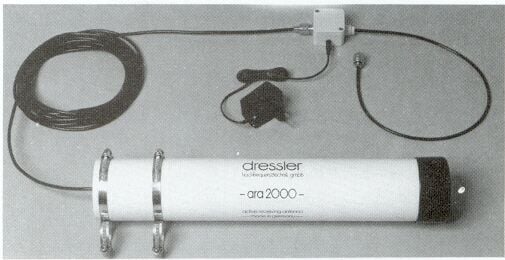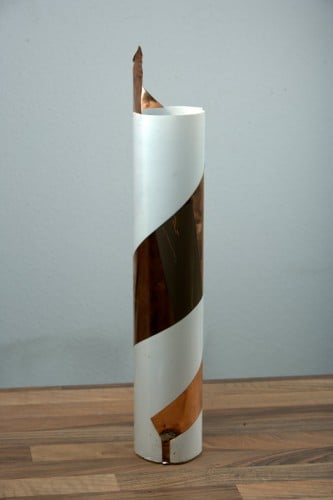Building an active wideband antenna for your SDR
As the RTL-SDR and other SDRs are wideband, we recommend that people use a wideband antenna if they want to scan over all the frequencies. Normally a discone or a scantenna is suggested as the wideband antenna of choice, however there are alternative designs such as the Dressler ARA-2000 which is a type of log spiral antenna that can receive from 50 – 2000 MHz. This particular product is no longer for sale, but an article detailing the breakdown of its construction can be found online.

The article shows how to build the antenna from scratch. The active element consists of a thin copper sheet (or copper foil) in the shape of a wedge which is rolled into a cylinder around a plastic sheet. It is then connected to a low noise amplifier (LNA), which is powered through a bias tee. For the LNA something like the LNA4ALL could be used if building it yourself.
This antenna may be something to consider if you are thinking about building your own wideband antenna. It has the advantage of being much smaller than a discone and it can also be fully enclosed in a plastic radome to that fully protects it from weather elements. The author of the article also writes that he saw better performance from this antenna than when compared with a discone.

Hi everyone,
Is it possible to change copper foil with aluminum one, and would it change antenna’s rf properties significantly?
Best regards
Always wanted to know what my ARA-2000 looked like inside, now I know – cheers 🙂
Great antenna btw, used mine for like 20 years, even works great as ADSB antenna…
Could it be the same concept of PA0RDT mini whip?
At first everyone wondered how that magic antenna could get so good reception being composed only of a LNA and a 3×3 cm pcb as antenna; then it became apparent that the real receiving antenna was not the pcb 3×3 but the shield of the coax cable. For this reason it was so important to place the antenna at a minimum height of 5-6 meters, because it needed a long vertical coax cable to receive
That’s the same antenna used in the websdr at Twente
Posted the same question in the linked page and the site owner replied
Hi Max,
Interesting new about the coaxial cable being part of the actual antenna of the Mini-Whip. Could you provide a reference or link to this statement? I currently understood that it’s meant to be hanged 5-6m high due to man made noise interference.
Hi Robin, in the past months i have been searching informations about the mini-whip and i read discussions in many ham radio forums and blogs. Unfortunatly i do not save every link when i read interesting informations but i will try to find the most relevant and let you know here. Meanwhile you may try to google, i supose with terms PA0RDT mini whip cable shield
p.s. i do not have time for an extensive search in this moment but i gave a quick look, start translating this; PA0RDT did himself a test to find out that with the coax cable it works, with optical cable is deaf
Hi Max,
I’ve read the article in your link and I also searched for some info myself. What I found was this:
http://wwwhome.cs.utwente.nl/~ptdeboer/ham/tn/tn07.html
and I quote from this particular website:
“It might be an idea to replace the coaxial cable by a glass fiber. That would eliminate all noise coming into the amplifier via the coaxial cable. But without any conductive connection to the outside, the entire circuit will be at the same potential, so the received signal will not cause a potential difference that can be passed on to the receiver. As a consequence, nothing will be received. PA0RDT recently tried this in practice and reported about it on the RSGB-LF mailing list: indeed, he received nothing. ”
Perhaps this refers to the beginning message from PA0RDT himself. I’ll need some more time to find some more useful information though.
If it is however true, I might have to change my setup as most of the coaxial cable length is rolled up to a coil inside my house as the cable is too long.
Hi Robin, la night i went to search for more links for you and i posted but the message was awaiting for moderation and was not published. I don’t know if i did something wrong but in this case somebody has to tell me, i do not want to be forced to change nick for no reason. I’m 51 yo, sw radio enthusiast since age of 12 and ham radio licenced since age of 19, i made my first dipole 37 year ago and installed my first 3el. beam 35 years ago, and even if life sometimes make you change route for a while and sure that some 20yo guy in the internet age will know much more than me, i am not the last dickhead arrived here after reading that a dongle can be hacked for free.
This is what i wrote last night:
the most relevant article that i have found is from VK1OD; his website was removed but you can still read it here at the waybackmachine. Unfortunatly the pictures are missing but there is a video available on youtube here
As i said earlier another relevant test to support the idea that the feed line is part of the antenna system was carried from PA0RDT himself replacing the cable with optical line. It was posted on yahoogroups here but i could not access it so i read the transcription in the italian forum mentioned before.
So no matter how high is the antenna, if you put the receiver on the top of the antenna mast closed to the mini whip you have poor reception. No coax, no party.[end]
Now, put this on bold, my comment was not so inherent because ARA-2000 is for VHF and the wavelenght is much closed to the phisical dimension of the antenna while the mini-whip is for much higher wavelenght. Was i off topic? somebody could have told me why, but still what i said could be usefull for others
Hi Max,
Thanks for the links, I’ll check them out. Your initial message was posted though (it’s below our conversation). If the coax shield is part of the antenna it would explain why an optical cable would not work and also why I’m picking up interference from my LCD monitor whilst my Mini Whip is located outside: I’ve used a long cable which is coiled up in my house to compensate for the long length, maybe this is picking up the LCD monitor interference. Unfortunately I’m not able to play around with the height or use a pole for the mini-whip, so I’m unable to experiment with height vs reception strength. So I hope I’ll find some definitive answers on the coax shield. Thanks for your info.
Robin, the most relevant article that i have found is from VK1OD; his website was removed but you can still read it here at the waybackmachine. Unfortunatly the pictures are missing but there is a video available on youtube here
As i said earlier another relevant test to support the idea that the feed line is part of the antenna system was carried from PA0RDT himself replacing the cable with optical line. It was posted on yahoogroups here but i could not access it so i read the transcription in the italian forum mentioned before.
So no matter how high is the antenna, if you put the receiver on the top of the antenna mast closed to the mini whip you have poor reception. No coax, no party.